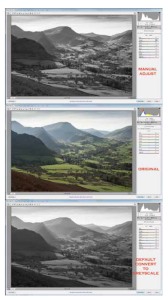articles/Monochrome/mike-mono-page6
Monochrome - choice of the connoisseurs - part 6 of 1 2 3 4 5 6 7 8 9 10 11
by Mike McNamee Published 02/02/2015

Conversion for Non-Raw Files
You may only have a TIFF or a JPEG-format file to work with and therefore be unable to exploit the Raw file workflow options. Within Photoshop there are a number of options available and of these the Black and White adjustment is preferred. However, it is only available on later versions of Photoshop and so for completeness we also cover the other possibilities and highlight their properties.
Mode>Grayscale
This is probably the fastest and easiest method. You click on Image>Mode>Grayscale and the job is done. Depending on your preference settings you may get a warning about discarding colour information. In the background, Photoshop is deploying a Channel mix of 60% green, 30% red and 10% blue. This is the least sophisticated of the conversion methods and produces an average conversion which might be suitable to your needs if 'average' is what you seek; if 'exceptional' is your goal you will almost certainly have to employ more robust techniques.
Image>Adjust>Desaturate
This method does not exactly reproduce the Mode>Grayscale result. When a test target (the Macbeth ColorChecker) was used, the conversion of the an RGB greyscale was the same; deep blue was made with 22 RGB points difference, the reds were 3 points different and green was 22 points different. The yellow-black borders displayed artefacts. The remarks about using Mode>Grayscale apply equally here.

Image>Adjust>HSB>Desaturate
This was an identical result to that above and is also probably best avoided.
Take The Lab Channel
This method found favour for some time but is now largely superseded by the ability to take just the lightness detail out of a Raw file. As used, the method involved converting the mode of the file into Lab then taking just the Lightness channel from the Channels Palette and making an image from that in greyscale. Many enthusiasts were keen on the method and oblivious to the fact that there were a number of uncontrolled variables such as the grey dot gain or gamma settings and the colour space settings, all of which influenced the translation to tones of grey. This method too is probably best avoided; it provides nothing that other methods can provide and is in no way as sophisticated as the Raw file route in terms of pixel handling.
Please Note:
There is more than one page for this Article.
You are currently on page 6
- Monochrome - choice of the connoisseurs page 1
- Monochrome - choice of the connoisseurs page 2
- Monochrome - choice of the connoisseurs page 3
- Monochrome - choice of the connoisseurs page 4
- Monochrome - choice of the connoisseurs page 5
- Monochrome - choice of the connoisseurs page 6
- Monochrome - choice of the connoisseurs page 7
- Monochrome - choice of the connoisseurs page 8
- Monochrome - choice of the connoisseurs page 9
- Monochrome - choice of the connoisseurs page 10
- Monochrome - choice of the connoisseurs page 11
1st Published 02/02/2015
last update 09/12/2022 14:56:44
More Monochrome Articles
There are 0 days to get ready for The Society of Photographers Convention and Trade Show at The Novotel London West, Hammersmith ...
which starts on Wednesday 15th January 2025





